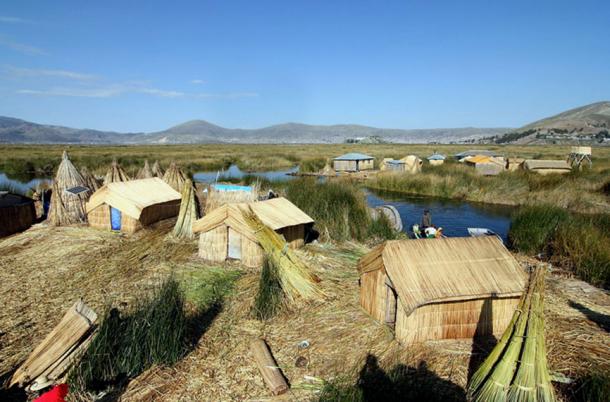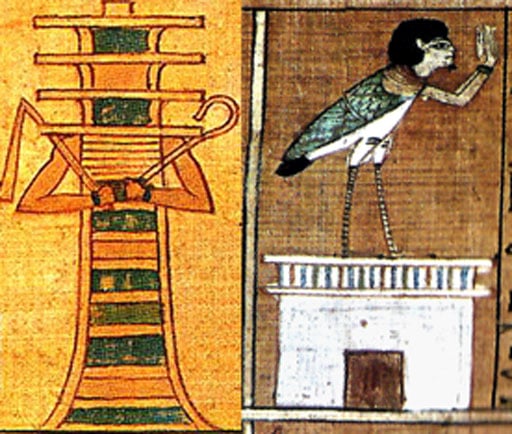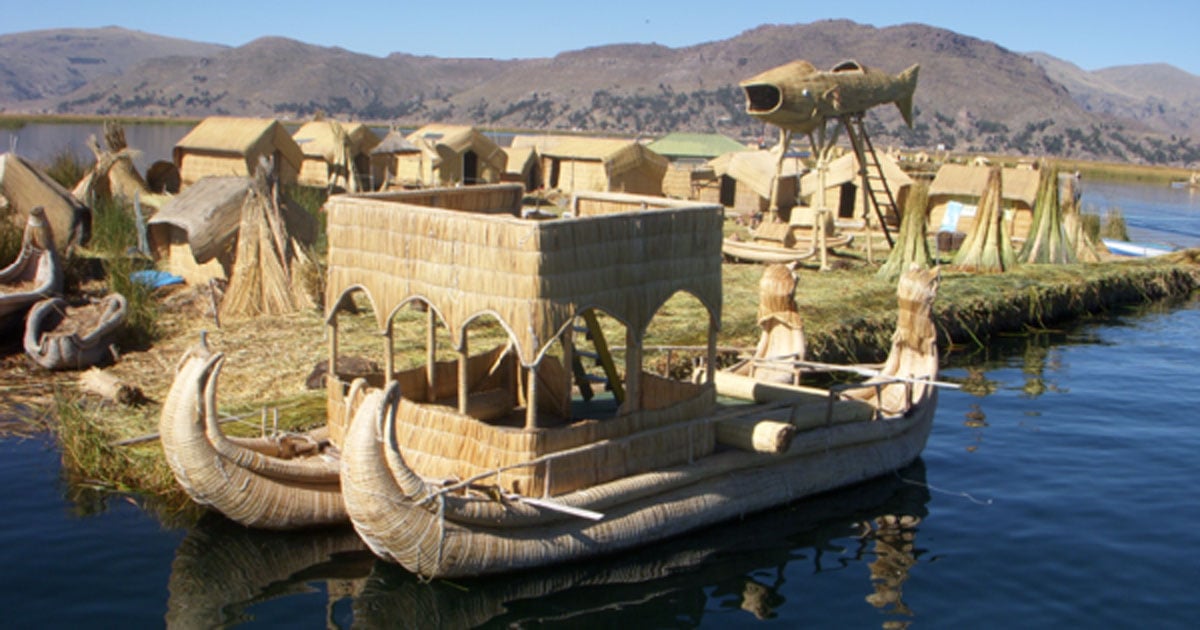The Sacred Meaning of the Reed: From Houses and Boats to Rituals, Ceremonies and Portals
Many cultures around the world either place a special importance on the hollow-stemmed reed plant or recognize a certain “place of the reeds” within their territory. Legends of the Hopi tribe in Arizona, for instance, tell of the previous world-age that was decimated by a great flood, mythological variations of which exist in most cultures across the globe. The few virtuous Hopis who still followed the ways of the Creator escaped the rising waters by crawling up through a bamboo reed that pierced the sky and stuck up into the next world like a kiva ladder. (A kiva is a subterranean, communal prayer-chamber.) This happened at an actual location called the Sipapuni in the bottom of Grand Canyon. In an alternate version of the legend, the Hopi escaped the deluge by sailing eastward on reed boats across the Pacific Ocean to dry land. In a ceremonial context, the Hopi use smaller reeds to make a storage case for a woman’s wedding robe woven of white cotton that will be buried with her after her death. The first village settled on the Hopi Mesas was called Songòopavi (Shongopovi), literally “place of the reeds,” and the tribe still has a Reed Clan. In addition, this clan is associated with the celestial “Heart of the Sky” god named Sótuknang. In fact, the Hopi word for the Milky Way is songwuka, literally “the big reed.”

Figure 1. Hopi bride carries a reed mat that contains her wedding blanket. She wears this blanket at the naming of her first child. In the end it becomes her shroud.
Aztecs and the Place of the Reeds
Mesoamerica also has a number of locations designated by the reed. The ancestral home of the Aztecs was known not only as “place of the herons” but also the “place of the reeds.” The Aztecs initially assumed that Hernando Cortés was the feathered serpent Quetzalcoatl making his prophesied return. Cortés and his conquistadores arrived on the Atlantic coast on Easter 1519, which was the Aztec year Ce Acatl, or One Reed. This year marked the end of a fifty-two year cycle when the world would either be renewed or destroyed. Sadly for the Aztec leader Moctezuma of Tenochtitlán (now Mexico City), the latter occurred.
The apotheosized chieftain of the Toltecs of northern Mexico was called Mixcoatl, or “Cloud Serpent.” About 900 AD his son, who was named Ce Acatl Topiltzin (a.k.a. Quetzalcoatl), founded the city of Tula, or Tollan. Its name again means the “place of the reeds.”

Figure 2. Atlantes (Toltec warrior statues) at Tula, Hidalgo, known as “place of the reeds.”
The late Linda Schele, expert on Mayan iconography, speculates that the original “place of the reeds” was the Gulf Coast swamps of the Olmec heartland, where civilization, writing, the arts, and organized warfare for this whole region began. Later the name was applied to the major Toltec center of Teotihuacán. Maya cities with this same identification include Uxmal, Copan, Tikal, and Utatlán.
Lake Titicaca and the Islands of Reeds
In Peru, the pre-Incan Uros people living around Lake Titicaca claim to be descendants of the builders of the Tiwanaku (Tiahuanaco). Some archaeologists estimate this grand city to be an astounding 15,000 to 20,000 years old. The Uros still reside on floating islands made of totora reeds. As the bottom of the islands rot away, they add more reeds to the top. This quintessential reed culture lives in reed houses, sails on reed boats, and weaves reed handicrafts. Totora was also used by the people of Rapa Nui (Easter Island) for thatching and to make swimming floats. North and South America are not the only places where the reed gained cultural significance.

Figure 3. Uros island made of reeds near Lake Titicaca.
Egypt and the Field of Reeds
Similar to the Greek Elysian Fields, the ancient Egyptian afterlife was called the Field of Reeds. An oasis called the Faiyum southwest of Giza was probably the naturalistic origin of this concept. Some of the vignettes in the Egyptian Book of the Dead depict the “heron of plenty,” otherwise known as the phoenix, perched on a small pyramid. It is interesting to note that the hieroglyph of a heron on a pyramid corresponds to the word bah, meaning “to flood, to inundate.” This, of course, is just the type of environment where reeds grow. In papyrus illustrations of the Field of Rushes we also find either the falcon or a small, human-headed bird representing the ba, sounding the same as the word bah previously mentioned. The ba, or “soul,” perches atop a pylon, which is a massive rectangular gateway to a temple or hypostyle hall. Thus, the pylon is a perfect symbol for a portal or stargate. In addition, the walls of the Field of Rushes were made of iron, presumably meteoric iron, which further stresses its celestial meaning.
Other vignettes show a celestial ship containing a staircase, which looks like half of a stepped pyramid cut vertically. These stairs represent transcendence and rebirth. In addition, the massive stone blocks of the Temple of Amun at Karnak were carved to give the illusion of being made of reed and papyrus. We furthermore remember that the sacred djed pillar was constructed of reeds. This symbol of stability was figuratively referred to as “the backbone of Osiris,” the god of the underworld that is associated with the constellation Orion.

Figure 4. Celestial barque from the Egyptian Book of the Dead.

Figure 5. Papyrus-shaped columns at the Temple of Amun, Luxor.

Figure 6. Heron or bennu bird (phoenix) atop a pyramidal perch.

Figure 7. Left: Egyptian djed pillar, anthropomorphized with flail and crook. Right: The Egyptian ba represented the “soul.” Standing on a pylon, this therianthrope raises his hands in prayer or praise.
In his book Starwalkers, “investigative mythologist” William Henry identifies ancient Egypt as another “place of the reeds,” or what he calls the Dimension of the Blessed. “The metaphor of the reed continues in the afterlife Field or Place of Reeds where it signifies the unfolding of a life in a finer realm, along the heavenly Nile, the Milky Way. Time and again we see paintings of priests and priestesses sailing on the waters of the heavenly Nile in the Blessed Field of Reeds. They are sailing the stars.” Or in other words, “As here, so hereafter.”

Figure 8. Norwegian explorer-author Thor Heyerdahl’s ‘Ra II’, reconstructed from ancient Egyptian drawings and models.
The more mundane usage of the reed was connected to writing. The reed’s cultural significance is emphasized by its use as both an instrument for writing and the material for making papyrus.
Musical Reeds
Music is also an earmark of culture. Reeds of different lengths are put together to form the panpipe, or syrinx. The Greek nymph Syrinx was lasciviously pursued by the satyr Pan and changed into a reed to escape violence.
The Babylonian creation myth called the Enuma Elish envisions a primeval time before reeds grew. Used for building houses and boats, the reed would become an essential cultural artifact for the ancient marshland dwellers of southern Iraq. One version of the creation describes the dragon slayer Merodach (Marduk) laying a reed upon the surface of the water and pouring dust upon it to create humankind.
Reeds in Sumerian Burial Customs
The Sumerian custom of human burial was called “laying the body in the ‘reeds of Enki’,” Lord of Earth. This might refer to placing a corpse in a small reed boat to float downstream into the canebrakes. The late author Philip Coppens in his book The Canopus Revelation stresses the cultural importance of the reed: “Throughout history, the center of worship of Enki in Eridu was the reed hut, even though it was surrounded by impressive temples. The reed hut was the original temple and it is important to note that despite technological advances, at the core of the religious belief, a simple hut remained. It shows that the Sumerians never forgot where they came from.”

Figure 9. Temple-like reed guesthouse, or mudhif, in southern Iraq (Mesopotamia).
Reeds in Creation Myths
The Japanese creation myth says that the first object to arise out of the ocean of chaos was a reed named Kunitokotachi, the eternal ruler of land. In Philippine mythology, the first man and woman named Sikalak and Sikabay came out of a split bamboo reed. In China, the bamboo was a symbol of longevity and was one of the Four Noble Plants. Its fiber was also used to make paper.
Given the variety of geographical locations across the globe for the “place of the reeds,” we may conclude that it is much more than a reference to flora. Ultimately the reed or bamboo designates a place of high culture and ancient wisdom—the sort of location where astronomer-priests would normally scan the heavens for doorways through which the soul could make its passage to the afterlife. For the Hopi Indians of Arizona, the reed certainly represents migration, a vast journey across either an ocean of salt water or an ocean of stars.
Whether used for houses, boats, ropes, writing implements, paper, musical instruments, or passageways to higher dimensions, the reed resonates through the winds of time, playing upon our imagination.
All images courtesy of the author.
Top image: Picture of a reed boat at the Floating Islands, on Lake Titicaca. (public domain)
Gary A. David is an author, independent researcher, and archaeo-astronomer. For over twenty-five years he has studied the archaeological ruins and rock art of the American Southwest. His nonfiction books explore Hopi mythology, star knowledge, and rituals, along with the traditions of other ancient cultures in Arizona and New Mexico. Website: http://www.theorionzone.com
References
E. A. Wallis Budge, An Egyptian Hieroglyphic Dictionary, Vol. I & Vol. II (New York: Dover Publications, Inc., 1978, 1920).
Phillip Coppens, The Canopus Revelation: Stargate of the Gods and the Ark of Osiris (Netherlands: Frontier Publishing, 2004).
David Freidel, Linda Schele, and Joy Parker, Maya Cosmos: Three Thousand Years on the Shaman’s Path (New York: William Morrow and Company, Inc., 1993).
Graham Hancock and Santha Faiia, Heaven’s Mirror: Quest For the Lost Civilization (New York: Crown Publishers, Inc. 1998).
William Henry, Starwalkers and the Dimension of the Blessed (Kempton, Illinois: Adventures Unlimited Press, 2007).
Norman Bancroft Hunt, Gods and Myths of the Aztecs: The History and Development of the Mexican Culture (New York: Smithmark Publishers, Inc., 1996).
Ekkehart Malotki, editor, Hopi Dictionary: A Hopi-English Dictionary of the Third Mesa Dialect (Tucson, Arizona: The University of Arizona Press, 1998).
Edmund Nequatewa, Truth of a Hopi: Stories Relating To the Origin, Myths and Clan Histories of the Hopi (Flagstaff, Arizona: Museum of Northern Arizona, 1967, reprint 1936).
New Larousse Encyclopedia of Mythology (London: The Hamlyn Publishing Group Limited, 1972, reprint 1959).
Evelyn Rossiter, editor, The Book of the Dead: Papyri of Ani, Hunefer, Anhaï (London: Miller Graphics/Crown Publishers, Inc., 1979, 1978).
Frank Waters and Oswald White Bear Fredericks, Book of the Hopi (New York: Penguin Books, 1987, reprint 1963).
Paul Westheim, The Art of Ancient Mexico (Garden City, New York: Anchor Books/Doubleday & Co., 1965).

















